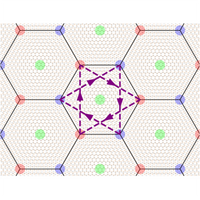Abstract
Twisted bilayer is a promising platform to investigate the interplay between band topology and many-body interactions. We present a theoretical study of its interaction-driven quantum phase diagrams based on a three-orbital model, which can be viewed as a generalization of the Kane-Mele-Hubbard model with one additional orbital and long-range Coulomb repulsion. We predict a cascade of phase transitions tuned by the twist angle . At the hole-filling factor (one hole per moiré unit cell), the ground state can be in the multiferroic phase, with coexisting spontaneous layer polarization and magnetism; the quantum anomalous Hall phase; and finally, the topologically trivial magnetic phases, as increases from 1.5° to 5°. At , the ground state can have a second-order phase transition between an antiferromagnetic phase and the quantum spin Hall phase as passes through a critical value. The dependence of the phase boundaries on model parameters, such as the gate-to-sample distance, the dielectric constant, and the moiré potential amplitude, is examined. The predicted phase diagrams can guide the search for topological phases in twisted transition metal dichalcogenide homobilayers.
6 More- Received 23 May 2023
- Revised 6 September 2023
- Accepted 12 October 2023
DOI:https://doi.org/10.1103/PhysRevX.13.041026
Published by the American Physical Society under the terms of the Creative Commons Attribution 4.0 International license. Further distribution of this work must maintain attribution to the author(s) and the published article’s title, journal citation, and DOI.
Published by the American Physical Society
Physics Subject Headings (PhySH)
Popular Summary
In solid-state materials, the interplay between electron interactions and band topology—which characterizes features similar to knots and twists in electronic band structure—can drive a plethora of intriguing quantum phases. Twisted bilayer is a promising platform for investigating this interplay. Here, two atom-thick layers of are stacked slightly askew to one another, creating a moiré interference pattern between the layers. It is the superlattice formed by this moiré pattern that provides a powerful platform for exploring various types of quantum phenomena. In this work, we present a theoretical study of the interaction-driven phase diagram of twisted bilayer at integer hole-filling factors, where each moiré unit cell has an integer number of doped holes.
Our study is based on an interacting three-orbital model, where each unit cell contains three electron orbitals. This model faithfully captures the band dispersion, symmetry, and topology of low-energy moiré bands for a large range of twist angles. We predict a cascade of phase transitions, tuned by the twist angle. When each moiré unit cell has just one doped hole, the ground state can change from a multiferroic phase with coexisting spontaneous layer polarization and magnetism, to a quantum anomalous Hall phase, and finally to trivial magnetic phases, as the twist angle increases. At two holes per unit cell, the ground state can have a continuous phase transition between an antiferromagnetic phase and a quantum spin Hall phase as the twist angle passes through a critical value.
Our constructed three-orbital model can serve as a theoretical framework for studying twisted bilayer , while the resulting theoretical phase diagrams can provide a guide for future experiments.



